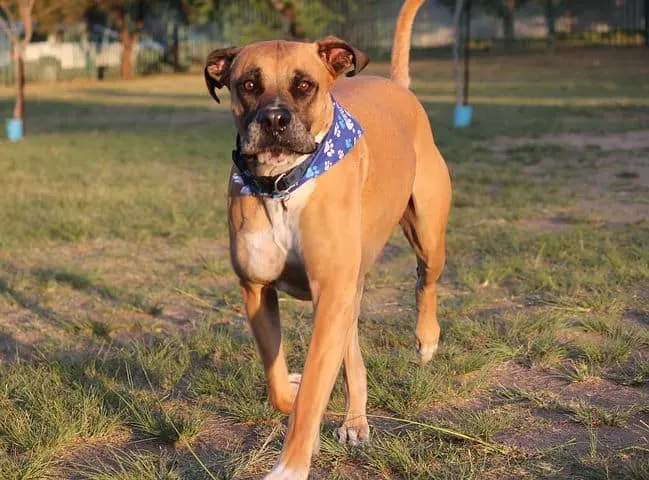Bullmastiff vs. German Shepherd: Which is The Better Protection Breed?
The German Shepherd is a dog breed that is embedded into the fabric of the popular culture.
This iconic dog breed is so beloved that even non-dog lovers can often name the breed just by sight alone.
The Bullmastiff is less well known in America but has a more well-known role in their home country of England.
Both of these dog breeds excel as guarding and protection dogs and both can make great companion canines as well.
But there are some critical differences to keep in mind when you are making a long-term commitment to a new dog friend.
In this article, we get to know the Bullmastiff and German Shepherd breeds so you can make the choice that is right for you.

Bullmastiff Vs. German Shepherd
The movie Rin Tin Tin forever embedded the German Shepherd into popular mainstream culture.
Just to see a German Shepherd is to fall in love with these regal, noble animals.
The Bullmastiff was originally nicknamed the “Gamekeeper’s Night Dog” for their critical role in protecting wild animals from poachers.
In England, these giant dogs are known to be unstoppable with foes but incredibly gentle with “their” people.
See a Bullmastiff Vs. German Shepherd
In this short and focused YouTube video, you can get a quick overview of the major similarities and differences between the Bullmastiff and the German Shepherd dog breeds.
Bullmastiff Vs. German Shepherd: Dog Breed History
With the Bullmastiff and the German Shepherd, you have two dogs from different parts of the world that were bred and trained to do two very different types of guarding and protection jobs.
This is also a big part of why the Bullmastiff and the German Shepherd dogs look so very different physically.
Bullmastiff history
The Bullmastiff hails from England originally. These dogs are descended from the ancient, giant mastiff dog breeds.
As the American Kennel Club (AKC) explains, today’s Bullmastiffs are bred to be 60 percent Mastiff and 40 percent Bulldog.
With their huge heads and broad necks combined with powerful bodies, any poacher would think twice before trying to poach game from land guarded by a Bullmastiff dog.
German Shepherd history
The German Shepherd was originally developed to be the “perfect” working and herding dog in Germany.
As the American Kennel Club (AKC) explains, the breed’s founder was a Cavalry officer named Captain Max von Stephanitz.
While today German Shepherds are quite uniform in appearance, the earliest German Shepherds were bred entirely for their working talents and appearance was secondary.
Today there are still lines: working German Shepherds and show German Shepherd dogs.
It is quite likely that the earliest German Shepherds were part wolf and part dog.
Bullmastiff Vs. German Shepherd: Personality & Temperament
With nearly 200 purebred dog breeds to choose from today, it can truly be said there is a dog breed for everyone.
When choosing between two working dog breeds like the Bullmastiff and German Shepherd, it is smart to consider your primary reason for wanting to add a dog to your life.
Because these dogs are quite different in some ways, you may find that one breed is a better fit for your life, schedule, available space, and family.
Bullmastiff personality and temperament
According to the American Kennel Club (AKC), the Bullmastiff is currently ranked as the 51st most popular purebred dog breed (out of 196 registered purebred dog breeds in the United States).
The Bullmastiff may have gotten their breed start guarding large tracts of stocked land at night, but today they are known for their skill in guarding properties of all sizes and their people.
The American Bullmastiff Club describes the personality and temperament of this breed as possessive, territorial, and intensely loyal but also docile.
They are famously gentle with family members of all ages when well trained and socialized.
German Shepherd personality and temperament
According to the American Kennel Club (AKC), the German Shepherd is currently ranked as the second most popular purebred dog breed (out of 196 registered purebred dog breeds).
The German Shepherd Dog Club of America (GSDCA) makes it very clear that you can see some personality and temperament differences between male and female German Shepherd dog in adulthood.
While these differences are not set in stone, in general males are said to be more territorial and aggressive and tend to bond more closely to one family member.
Females are said to be more inclusive in their bond with their family and easier to handle for first-time dog owners.

Bullmastiff Vs. German Shepherd: Size, Height and Weight
The Bullmastiff is always going to win any size contest when compared with a German Shepherd.
However, a bigger dog often means bigger toys, crates, carriers, beds, food bags, and more.
It is worth considering how many dogs will fit comfortably into your home, your vehicle, and your life.
Bullmastiff size, height, and weight
The Bullmastiff is descended from the ancient, giant mastiff dog breed lines.
These dogs typically weigh between 100 and 130+ pounds, with females being about 10 pounds lighter than males.
Bullmastiff dogs typically stand 24 to 27 inches tall (paw pads to shoulder girdles), with males standing about an inch taller than females.
German Shepherd size, height, and weight
The German Shepherd breed is often said to have begun with a wolf-dog hybrid of unknown origin.
These dogs are sleek and slim overall, weighing between 50 and 90 pounds and standing 22 to 26 inches tall (paw pads to shoulder girdles).
On average, males will weigh 15 pounds more and stand two inches taller than females.
Bullmastiff Vs. German Shepherd: Training and Exercise Needs
When you are comparing two working dog breeds and trying to decide which dog breed is a better fit for your home and lifestyle, it is always smart to consider how much training and daily exercise your new dog will need.
Your goal is to find a dog that is a good match with your own time availability and activity preferences.
This way, you can give your dog enough daily exercise so they will stay content and not become destructive.
Bullmastiff training and exercise needs
The Bullmastiff is a strong, confident, smart dog that is never going to be hesitant to jump into the fray in a protective role.
But this also means you need to start teaching your dog early on in life how to tell the difference between a friendly or neutral situation and a genuine threat.
Bullmastiffs tend to be more energetic and active in puppyhood than adults, although some will stay energetic throughout life.
Some Bullmastiffs will become more sedentary as they grow older.
Because there can be variance here from one dog to the next, meeting your puppy’s parents is the best way to try to predict how active your dog will grow up to become.
German Shepherd training and exercise needs
German Shepherds have a strong need to stay active and engaged every day.
These dogs have always been working dogs to their core and are accustomed to doing demanding work for long hours at a stretch.
These dogs do best when they have either a job to do or canine athletics to participate in.
You can expect your puppy to become destructive if you don’t offer enough playtime and engagement.
German Shepherds need early and ongoing direction and training to learn how to be a part of a family and community and distinguish between friends and foes.
These dogs really need to be at the center of your world and daily life and do not do well being left in the backyard or even in the company of other dogs.

Bullmastiff Vs. German Shepherd: Coat Care, Shedding & Grooming
If you are concerned about how much your new canine companion is likely to shed, you are not alone.
Shedding versus non-shedding dogs has become one of the hottest topics in the canine world today.
While there is no such animal as a truly “non-shedding” dog breed, there are dogs that shed less visibly than others.
However, neither the Bullmastiff nor the German Shepherd falls into this category.
Bullmastiff coat care, shedding, and grooming
The Bullmastiff has a short, neat, single-layer coat that will shed moderately all year long and more profusely when the seasons change.
However, you won’t have a lot of grooming or coat maintenance to do and you can simply bathe your dog as needed.
German Shepherd coat care, shedding, and grooming
The German Shepherd has a medium-length, thick, double-layer coat with a water-resistant outer layer and a thick, insulating inner layer.
Some owners have nicknamed the German Shepherd the “German Shedder,” which gives you an idea of how often and how much these dogs shed!
German Shepherds have traditionally worked outdoors in some very difficult weather conditions. Their coats serve a protective purpose and this is why they shed so much.
In addition to shedding year-round, your German Shepherd will do something called the “coat blow” seasonally.
You will definitely want to keep a de-linting brush and vacuum cleaner handy for this time.
German Shepherds don’t need any special coat care other than regular brushing and baths as needed.
The more you brush your dog, however, the less shed hair you are likely to have to sweep up.
Bullmastiff Vs. German Shepherd: Longevity & Health Issues
Whenever you start looking at sharing your life with a large to a giant dog breed, you are typically going to be looking at a dog with a shorter life expectancy.
Here, it is particularly important to find out everything you can about potential health issues so your dog has the healthiest life possible during the years you have together.
Bullmastiff longevity and health issues
According to the Canine Health Information Center (CHIC) database, the Bullmastiff breed has the following known possible genetic health issues you need to be aware of:
- Hip dysplasia
- Elbow dysplasia
- Autoimmune thyroiditis
- Eye issues
- Cardiac issues
- Kidney disease
The Bullmastiff has a typical life expectancy of seven to nine years.
German Shepherd longevity and health issues
According to the Canine Health Information Center (CHIC) database, the German Shepherd breed has the following known possible genetic health issues you need to be aware of:
- Hip dysplasia
- Elbow dysplasia
- Temperament issues
- Autoimmune thyroiditis
- Eye issues
- Cardiac issues
- Degenerative myelopathy
The German Shepherd has a typical life span of seven to 10 years.
Bullmastiff Vs. German Shepherd: Guarding and Protection Instincts
As you now know, both the Bullmastiff and the German Shepherd dog breeds have evolved to serve in protective and guarding roles.
However, they have held very different jobs over the centuries, with Bullmastiffs principally charged with defending a set piece of land from mainly human poachers and German Shepherds traveling with herds and guarding them against animal predators.
This can mean one dog breed might end up being a better fit for your personal needs, even though both will come equipped with equal guarding and protective instincts.
Bullmastiff guarding and protection instincts
The Bullmastiff is so large and imposing that simply facing down 100+ pounds of dog may be enough to send most intruders running!
If that isn’t enough, their bark will come next.
You want to be sure your puppy gets started in socialization and training around strange people and dogs right away so hopefully, they will never have to use their bite.
German Shepherd guarding and protection instincts
The German Shepherd is a top choice today for K-9 work in the police, military, and civilian jobs.
These dogs are quite simply unstoppable canine athletes with the smarts and confidence to match.
German Shepherds are not stubborn in general but they are so intelligent that boredom in training can be a problem.
They are also sensitive and highly attuned to their people so that you must only use positive (rewards-based) training with these dogs.
Getting your German Shepherd puppy started early with socialization and training around strange people and pets can help keep the protective instincts in check.
However, you should not trust your German Shepherd off-leash in any non-fenced area as these dogs have an irresistible urge to chase (prey drive).
Rather, consider involving your dog in canine athletics to burn off extra energy and satisfy prey drive instincts.

Bullmastiff Vs. German Shepherd: Good with Kids & Other Pets
If you have young children or babies and other family pets, you want to tread with caution whenever you are adding another animal to your family.
The truth is, some dog breeds just make better family pets than do others.
Both the Bullmastiff and the German Shepherd can integrate well into a family of all ages but their needs are different to make this happen.
Bullmastiff good with kids and other pets
Bullmastiffs can be good with kids, as VetStreet points out.
However, because the Bullmastiff is so enormous size-wise, there could be some risk if your dog sits down on your child or another smaller pet accidentally.
Bullmastiffs are not known to be particularly good with cats and other small prey-type pets because their prey drive is very strong.
The exception might be if they are raised together with other pets from early puppyhood.
German Shepherd good with kids and other pets
As Canine Journal points out, German Shepherds can get along well with kids and other family pets, but it will depend on your involvement to make sure this happens.
German Shepherd puppies that are raised with other pets from early puppyhood will have a better chance of growing up to consider these other animals’ family members and not prey to chase.
German Shepherds can be very loving and loyal protectors of children but may be less tolerant of rough play from kids that are too young to know how to interact gently with a dog.
This is especially the case when you pair a full-size (90+-pound) male German Shepherd with young kids.
If you are a first-time dog owner and trainer and you have young kids and you really want a German Shepherd, there are many breeders and trainers who would advise you to select a female German Shepherd.
Bullmastiff Vs. German Shepherd: Which Is the Right Dog For You?
So now you have a good foundational understanding of the similarities and differences between these two working and protection dog breeds.
As you can see, Bullmastiffs and German Shepherds are both guard and protection dogs but they were developed to do very different jobs in very different situations.
If you have the time, energy, space, and experience with dog training, either of these dog breeds might make a great next canine companion for you.
Related Reading: Tibetan Mastiff German Shepherd Mix Breed Facts and Traits






























